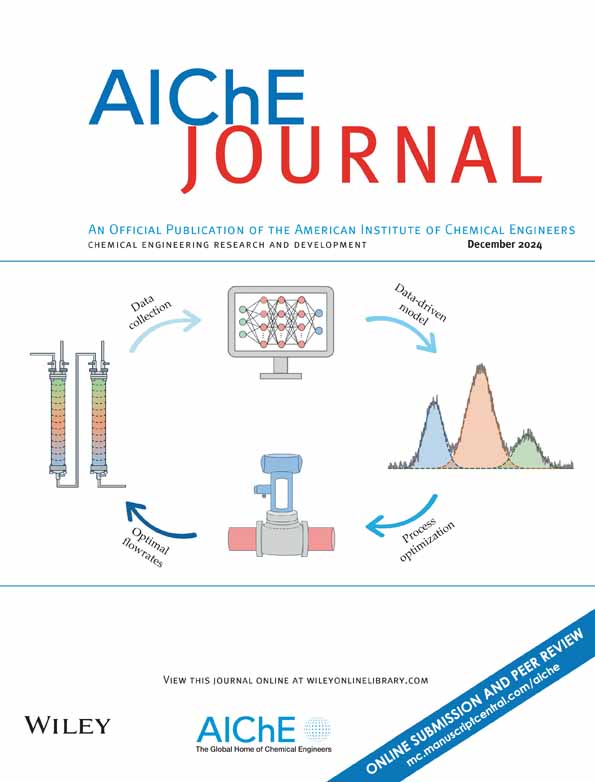Interpretable machine learning-assisted high-throughput screening of highly active nitrogen fixation dual-atom catalysts
IF 3.5
3区 工程技术
Q2 ENGINEERING, CHEMICAL
引用次数: 0
Abstract
Machine learning (ML) has addressed the traditional challenges of large data processing in density functional theory (DFT) calculations. However, understanding the relationship between fundamental descriptors and catalytic performance and identifying key drivers of catalytic activity remain challenging. Here, we present a cost-effective, high-throughput, and interpretable ML method to accurately identify nitrogen reduction reaction (NRR) performance determinants. Initially, 378 M1M2@TiO2 catalysts are screened, yielding 33 promising candidates through high-throughput techniques. Subsequently, ML models (primarily XGBoost) predict free energy changes of key NRR intermediates. Shapley Additive Explanations (SHAP) analysis identifies two critical features: the M1NN bond angle (M1NN) and the M2N bond length. Four catalysts exhibiting energy changes below 0.3 eV in the potential-determining step are identified as promising candidates. Combined SHAP analysis and electronic structure calculations confirm the inherent activity of NRR catalysts, highlighting the importance of fundamental properties in modulating active sites for superior NRR performance.可解释的机器学习辅助高通量筛选高活性固氮双原子催化剂
机器学习(ML)解决了密度泛函理论(DFT)计算中传统的大数据处理难题。然而,理解基本描述符与催化性能之间的关系以及识别催化活性的关键驱动因素仍然具有挑战性。在此,我们提出了一种具有成本效益、高通量和可解释性的 ML 方法,用于准确识别氮还原反应(NRR)性能的决定因素。首先,我们筛选了 378 种 M1M2@TiO2 催化剂,通过高通量技术筛选出 33 种有希望的候选催化剂。随后,ML 模型(主要是 XGBoost)预测了关键 NRR 中间产物的自由能变化。Shapley Additive Explanations (SHAP) 分析确定了两个关键特征:M1NN 键角 (M1NN) 和 M2N 键长。四种催化剂在电位决定步骤中表现出低于 0.3 eV 的能量变化,被确定为有希望的候选催化剂。结合 SHAP 分析和电子结构计算,确认了 NRR 催化剂的固有活性,突出了基本特性在调节活性位点以获得优异 NRR 性能方面的重要性。
本文章由计算机程序翻译,如有差异,请以英文原文为准。
求助全文
约1分钟内获得全文
求助全文
来源期刊

AIChE Journal
工程技术-工程:化工
CiteScore
7.10
自引率
10.80%
发文量
411
审稿时长
3.6 months
期刊介绍:
The AIChE Journal is the premier research monthly in chemical engineering and related fields. This peer-reviewed and broad-based journal reports on the most important and latest technological advances in core areas of chemical engineering as well as in other relevant engineering disciplines. To keep abreast with the progressive outlook of the profession, the Journal has been expanding the scope of its editorial contents to include such fast developing areas as biotechnology, electrochemical engineering, and environmental engineering.
The AIChE Journal is indeed the global communications vehicle for the world-renowned researchers to exchange top-notch research findings with one another. Subscribing to the AIChE Journal is like having immediate access to nine topical journals in the field.
Articles are categorized according to the following topical areas:
Biomolecular Engineering, Bioengineering, Biochemicals, Biofuels, and Food
Inorganic Materials: Synthesis and Processing
Particle Technology and Fluidization
Process Systems Engineering
Reaction Engineering, Kinetics and Catalysis
Separations: Materials, Devices and Processes
Soft Materials: Synthesis, Processing and Products
Thermodynamics and Molecular-Scale Phenomena
Transport Phenomena and Fluid Mechanics.
 求助内容:
求助内容: 应助结果提醒方式:
应助结果提醒方式:


